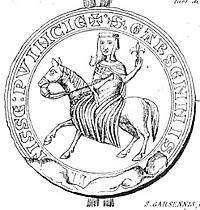Garsenda, Countess of Forcalquier facts for kids
Quick facts for kids Garsenda |
|
|---|---|
| Countess of Provence Countess of Forcalquier |
|

Garsenda as she appears on her seal, from drawing by Louis Blancard (1860)
|
|
| Born | c. 1180 |
| Died | c. 1242/1257 |
| Spouse | Alfonso II, Count of Provence |
| Issue | Ramon Berenguer IV Garsenda of Provence, Viscountess of Béarn |
| House | Sabran |
| Father | Rainou of Sabran |
| Mother | Garsenda of Forcalquier |
Garsenda (born around 1180 – died around 1242/1257) was a powerful woman in the history of a region called Occitania. She was the Countess of Provence because she was married to Alfonso II. She also became the Countess of Forcalquier in her own right, meaning she inherited the title herself. Later, she brought these two areas, Provence and Forcalquier, together. Garsenda was also a big supporter of Occitan literature, especially poets called troubadours. She even wrote some poems herself and is known as a trobairitz (a female troubadour) under the name Garsenda de Proensa.
Contents
Becoming a Countess: Garsenda's Early Life and Marriage
Garsenda was the daughter of Rainou, a lord from the House of Sabran. Her mother was also named Garsenda, and she was the daughter of William IV of Forcalquier. Garsenda was named after her mother. Her mother was supposed to inherit Forcalquier from William IV, but she passed away before him. This meant that Garsenda herself inherited the county of Forcalquier from her grandfather, William IV.
When Garsenda was only thirteen years old in 1193, her grandfather William IV and Alfonso II signed an important agreement called the Treaty of Aix. This treaty said that Garsenda would inherit Forcalquier and would marry Alfonso. Alfonso was set to become the Count of Provence. Their marriage happened in July 1193 in Aix-en-Provence. Garsenda and Alfonso had at least two children: a son named Raymond Berengar IV and a daughter also named Garsenda. Their daughter Garsenda later married Guillermo II de Montcada and had two children, including Gaston VII, Viscount of Béarn.
Leading Provence: Garsenda's Regency and Support for Arts
In 1209, both Garsenda's grandfather William IV and her husband Alfonso died. This meant their son, Raymond Berengar IV, became the new Count. Since he was still young, Garsenda became his natural guardian and the Regent of Provence. A regent is someone who rules a country when the rightful ruler is too young or unable to rule.
At first, Alfonso's brother, Peter II of Aragon, chose his other brother, Sancho, to be the regent of Provence. But when Peter died in 1213, Sancho became the regent of Aragon and gave control of Provence and Forcalquier to his son, Nuño Sánchez.
There was a lot of disagreement between the Catalans (supporters of Nuño) and the people who supported Garsenda. They accused Nuño of trying to take over the county from her son. The local nobles in Provence first tried to use this situation for their own benefit. However, they eventually decided to support Garsenda. They removed Nuño, who then went back to Catalonia. Garsenda officially became the regent, and a council of local nobles was formed to help her rule.
It was likely during her time as regent (from about 1209/1213 to 1217/1220) that Garsenda became a central figure for poets. She was known for supporting artists and writers. One poet, Elias de Barjols, wrote songs about her. There's even a special type of poem called a tenso (a debate poem) between a "good lady," who is identified as the Countess of Provence, and an unknown troubadour. In this poem, the countess expresses her feelings for the troubadour, who replies politely. Another poet, Raimon Vidal, also praised Garsenda for her famous support of troubadours.
Later Years: Retirement and Legacy
Around 1220, a man named Guillaume II de Sabran, who was a nephew of William IV, tried to claim Forcalquier. He had been causing trouble in the region of Sisteron. However, he was stopped, partly thanks to the help of the Archbishop of Aix. By 1217 or 1220, Garsenda had officially given Forcalquier to her son and stepped down from ruling.
Garsenda later retired to a monastery called La Celle around 1225. In 1242, she visited her new great-granddaughter, Beatrice of England, and Beatrice's parents in Bordeaux. Beatrice's father, Henry III of England, was fighting a war in France at the time. Garsenda brought 60 knights to help him. It is possible that Garsenda lived until 1257. In that year, a woman named Garsenda made a donation to a church. She asked that three priests pray for her soul and her husband's soul.
Garsenda's Poetry
Garsenda was one of the few women who wrote poetry during her time. Here is an example of her work:
|
|
See also
 In Spanish: Garsenda de Sabran para niños
In Spanish: Garsenda de Sabran para niños


